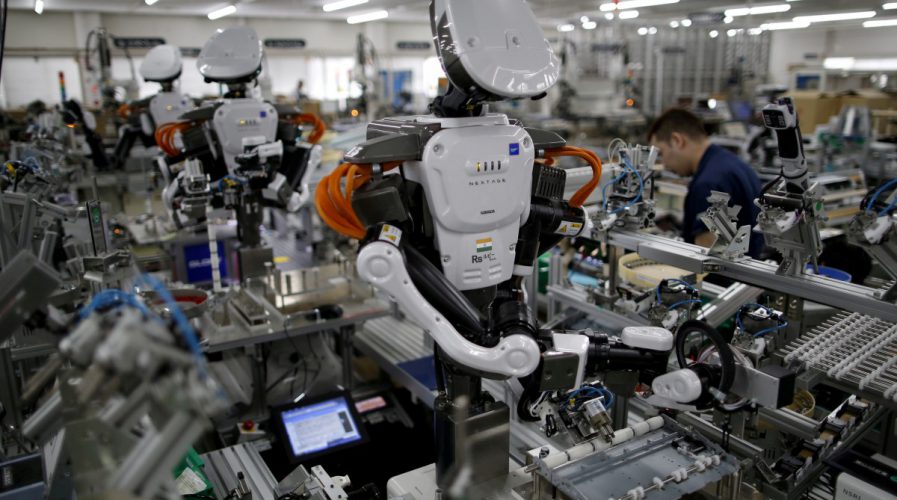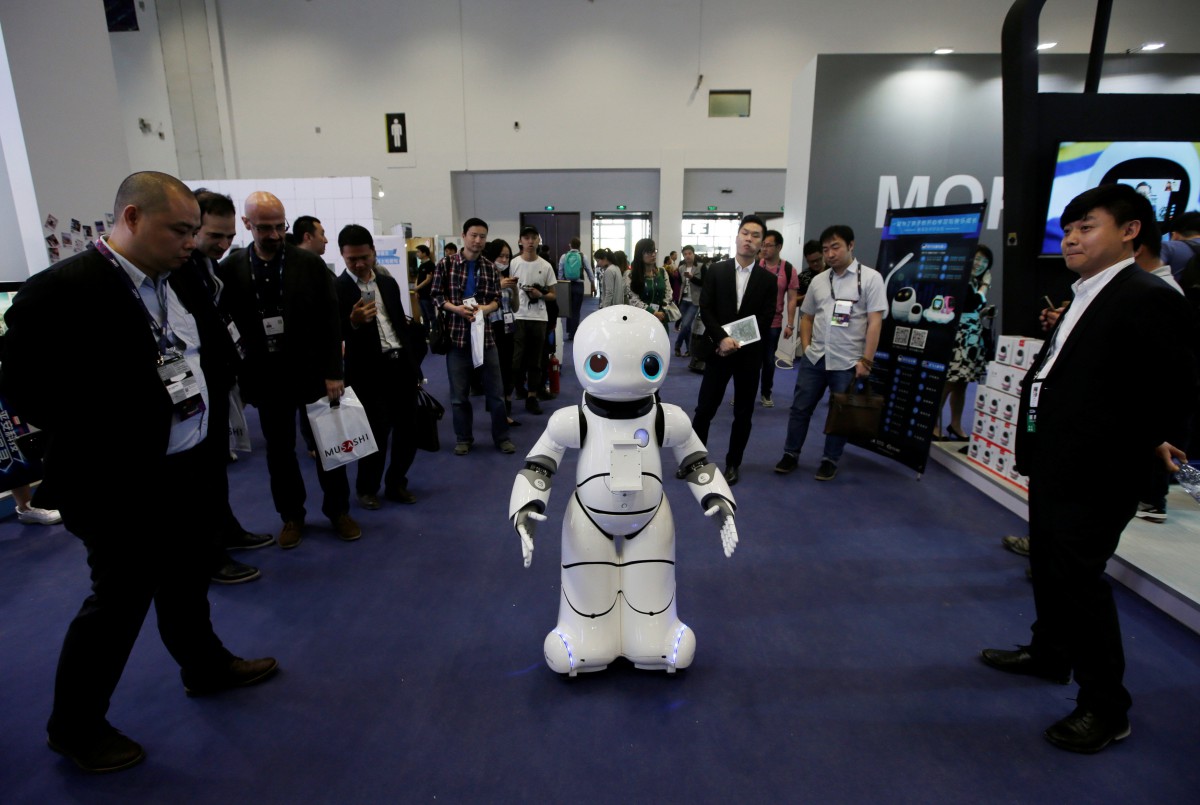
Japan recorded their first downgrade of the economy for the first time in eight months due to a fall in machine orders. Source: Reuters
Robots are getting cheaper, good news for SMEs and labor-short Japan
AS JAPAN continues to grapple with falling population rates, which have begun to adversely affect labor demands, the country is increasingly turning to robots to make up for what they lack in manpower.
Japan’s labor shortage problems are not new, but the increasingly graying society is limiting the spectrum of jobs that can be carried out. According to Reuters, Japan working population of Japan peaked in 1995 at 87 million. That number has been falling since then; the Labor Ministry expects the number to drop to 76 million in 2017, and 45 million by 2065.
I went to see the humanoid robot Asimo at the @miraikan and was blown away! #robotics #japan pic.twitter.com/OT64rSq6Nm
— Alex Schearer (@alexschearer) May 14, 2017
It’s an unsurprising fact, particularly as birth rates in Japan are also declining (though The World Bank noted a slight uptick in the last decade).
However, times are grim for Japan’s labor force – Labor Ministry data showed for the fiscal year ending March 31, 2016, mid-sized companies with 100 to 499 workers advertised to fill 1.1 million new positions, the highest in five years and almost five times the number of open positions at companies with 500 workers or more.
So it is not surprising Japan is beginning to replace manpower with robot-power. Mid-sized companies are planning larger investments to purchase robots and other equipment designed to automate a wide range of tasks, such as manufacturing, earthmoving, and hotel and office concierge services.
The Bank of Japan conducted a survey of companies looking to invest in robots, and reported companies with share capitals of JPY100 million (US$880) to JPY1 billion (US$8.8 million) plan on increasing the percentage of capital expenditure spent on robots and automation by an average of 17.5 percent, making it the highest level on record.
SEE ALSO: China shifts into high gear in race to become robotics world leader
“The share of capital expenditure devoted to becoming more efficient is increasing because of the shortage of workers,” Seiichiro Inoue, a director in the industrial policy bureau of the Economy, Trade and Industry Ministry (METI_, said to Reuters.
The Japanese government sees many benefits of larger dedicated portions for automation investment: the more money companies begin pumping into labor-saving, accurate equipment, the more productive companies will become, and this, in turn, will boost the country’s languishing economy.
The effect of increased automation spending has been noticeable in the account books of robot-makers. Revenues at many Japanese robot companies have risen in the first quarter of this year, the first rise on record in many quarters.
Where is the spending happening?
Generally, industries, such as manufacturing and construction, are seeing the largest hikes in investment spending.
Hitachi Construction Machinery has seen orders for its computer-programmed digging machines rise – the robot is able to use global positioning systems to hew ditches that are frighteningly accurate, and can halve digging time.
Kawasaki Heavy Industries Ltd. also noted its two-armed, 170cm robot – developed to be adapted into a range of industries from electronics, to food processors and drug companies – has been selling well.
家族旅行。 #hennahotel #変なホテル に来てます。 pic.twitter.com/cefTx7Ubxv
— mana-mína (@noromanami) April 5, 2017
Even those in the hospitality business are getting in on the robots trend.
The “Hen na Hotel”, or the “Odd Hotel” located near Disneyland Tokyo has integrated 140 different robots and an artificial intelligence concierge system in lieu of a full-on human staff.
The 100-room “robot hotel” can be staffed with as few as two to three people, manager Yukio Nagai told Reuters.
The artificial intelligence software is mediated through an egg-shaped robot called Tapia, which is an Alexa-like personal assistant that integrates not only voice commands but facial recognition technology. Tapia is designed to automate all the tasks usually handed to hotel staff, such as wake-up calls, as well as other more personal ones such as schedule management, and management of in-room facilities such as the air conditioning and television.
“Originally, we sold this product for use in the home, but now we are getting a lot of enquiries from companies,” said Sayaka Chiba, a director at MJI Co, which makes the Tapia.
“Banks, hospitals, and hotels are interested in using Tapia for reception work and communicating with customers.”
“Companies say they are interested in Tapia because of labor shortages. Nursing homes are also interested,” she said. “We’ll continue to sell this for use in the home, but all the interest from companies show the market has somewhat shifted.”
SEE ALSO: Will we really make love with robots? Yes, says Malaysia’s Prof. Adrian David Cheok
If the price is right
Perhaps more than any other sector of the industry, small- and medium-sized businesses are benefiting the most from robots, whose prices are beginning to plunge compared to the early days of robotic automations.
In the US, robots are beginning to turn up in small factories, fostering hope US manufacturing may experience a revival, as reported by Bloomberg.
Mid-sized companies plan to increase spending much more than large-caps, which are projecting just a 0.6 percent increase in the fiscal year, according to the Bank of Japan. Smaller companies tend to have less flexibility in overcoming labor shortages by paying workers more or by moving production overseas.
With the introduction of cheaper, kinder and easy to set up robots, collaborative models or “cobots” are some of the more effective robots driving up the efficiency of US factories, and also allowing SMEs to spend less for the same level of manpower, but with the added bonus of accuracy and sustained productivity.
“It’s just being brought down to an affordability level that gets to the smaller manufacturer,” Task Force Tips Inc. chief executive officer Stewart McMillan told Bloomberg.
“You can sit down with these things and, in a matter of minutes, watch a couple of YouTube videos and know how to do basic programming.”

A robot from UROBOT dances at the Global Mobile Internet Conference (GMIC) 2017 in Beijing, China. In the future, China and South Korea will also have to grapple with falling labor forces. Source: Reuters
“More than 90 percent of Japan’s companies are small- and medium-sized, but most of these companies are not using robots,” Yasuhiko Hashimoto, who works in Kawasaki’s robot division, told Reuters. “We’re coming up with a lot of applications and product packages to target these companies.”
Task Force Tips is one of the companies in the US trying to bring more automation in for the North American country. They supply fire-hole nozzles, which are made through a synthesis of machine and human labor.
In this case, automation is a proven ingredient for higher productivity, but McMillan also points out robots are helping SMEs compete with corporations and countries like China, which benefit from low-wage labor as well as the economies of scale.
SEE ALSO: Vinclu’s Gatebox AI assistant wants to have a relationship with you
Automation has a bad rep for wiping out jobs, especially in America where protectionist sentiments are driving up worries of unemployment significantly.
The prevailing prediction is that robots will dramatically alter the nature of our lives, as an economist from the Massachusetts Institute of Technology and Boston university noted the number of jobs and wages will fall as automation rises.
This is, of course, less of a problem in Japan, where robots are coming to represent a more and more significant aspect of life.
Be sure though, Japan’s synthetic technological solution to their labor problem will be one that will be heavily scrutinized by China and South Korea, who will almost certainly face their own labor shortage problems in the near future.
Additional reporting by Reuters
READ MORE
- Ethical AI: The renewed importance of safeguarding data and customer privacy in Generative AI applications
- How Japan balances AI-driven opportunities with cybersecurity needs
- Deploying SASE: Benchmarking your approach
- Insurance everywhere all at once: the digital transformation of the APAC insurance industry
- Google parent Alphabet eyes HubSpot: A potential acquisition shaping the future of CRM
